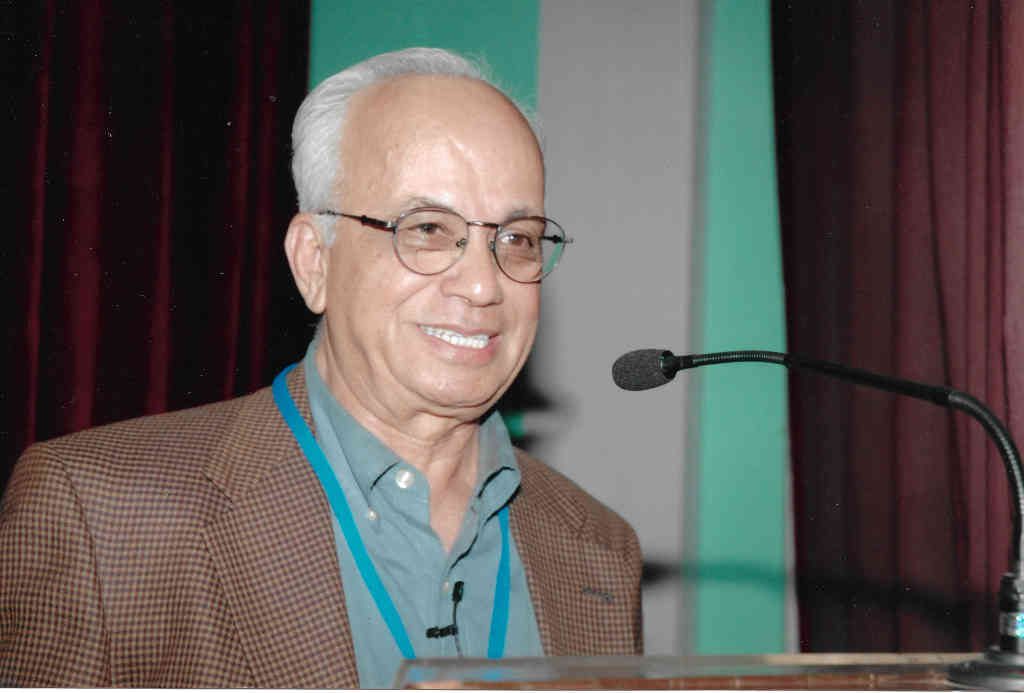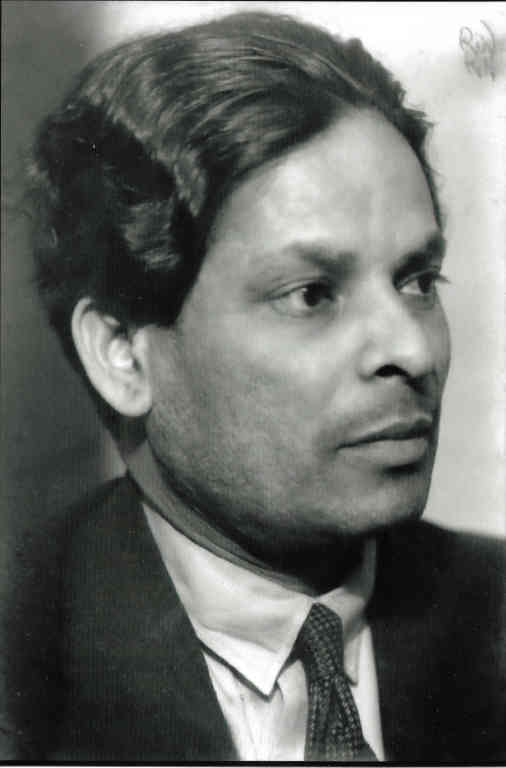PR Krishnaswamy, who was a student in the Department of Biochemistry in the 1950s, went on to have a distinguished yet unconventional research career. In the first of this two-part profile, Krishnaswamy, now 91, describes the influence of his mentors in the Department.

PR Krishnaswamy has taken a meandering path. Unlike many of his fellow students at the Department of Biochemistry in the 1950s, his research career has been spent mostly outside academia. In the process, he has made notable contributions spanning disciplines, working on protein chemistry, enzymes and amino acids, which have helped improve childhood nutrition and have had an impact on clinical pathology of diseases such as diabetes, multiple sclerosis and cancer.
This interest in work that not only satisfies scientific curiosity but also has practical applications is a predilection that he attributes to the influence of his mentors. Among them are the faculty members with whom he worked at the Department, particularly M Sreenivasaya and KV Giri, whose own work straddled the presumed divide between basic and applied sciences. “Their approach,” says Krishnaswamy, “influenced me in whatever I have done later.”
After completing his doctoral work in 1957, Krishnaswamy worked at the lab of Alton Meister, a renowned biochemist at the Tufts University School of Medicine in Boston, USA. But when Krishnaswamy came back to India in 1963, he did not have a job. He eventually found a temporary position at the Central Food Technology Research Institute, Mysore, before heading the Protein Foods and Nutrition Development Association of India. Later, he founded and led the pathology laboratories at Jaslok Hospital and Research Centre, Mumbai, and the Vittal Mallya Scientific Research Foundation in Bangalore – where his work led to one of the first patents for recombinant insulin in India. He also simultaneously served as the Executive Director at Mallya Hospital before joining Manipal Hospital as Director of its Diagnostic Services and Research division, where he trained many students. He is now a visiting scientist at the Centre for Nano Science and Engineering, IISc, consulting for PathShodh, the startup that is developing devices for monitoring diseases like diabetes.
“Their [Sreenivasaya and Giri’s] approach influenced me in whatever I have done later”
Krishnaswamy, born in 1929, grew up in a Bangalore where child mortality was common; his own parents lost four children. Plague was a pervasive fear, with people evacuating their homes at the sight of a dead rat. Food was scarce, healthcare facilities were meagre, and even basic medicines – at a time when cholera, diarrhoea and amoebic dysentery were common – were not readily available.
The education system, however, was different. Because of the Great Depression at the time and the lack of job opportunities, many who were highly educated chose to become teachers. Krishnaswamy remembers that many of his teachers at Malleswaram High School were Master’s degree holders. “We had great teachers and also beautiful labs,” he says.
After completing high school and Intermediate, he joined Central College for his BSc. During this time, he was already familiar with IISc through his uncle CN Acharya, a microbiologist, who had worked at IISc with Gilbert Fowler (the first Chair of the Department of Biochemistry) on sewage treatment and compost. While at college, his interests started veering towards biology, sparked by the book Microbe Hunters (by American microbiologist Paul de Kruif, published in 1926), that presented the discovery and study of microbes as a scientific adventure. For Krishnaswamy, the book was, in some ways, a preview of all the advances that were yet to come in the chemistry of life. “For example, at the time I was a student, most of the vitamins were discovered,” he says, “and amino acids which make proteins were discovered.” But nucleic acids and enzymes were just beginning to be intensely studied.
After college, Krishnaswamy joined the Department of Biochemistry at IISc in 1951 to work towards his Master’s degree in Sreenivasaya’s Fermentation Technology laboratory. He had heard about Sreenivasaya from reading the journal Current Science, of which Sreenivasaya was the editor (1942-50). “He would come to the lab at 7:30 am, lecture for an hour and then for an hour show us a lot of techniques including glass blowing to make our own pipettes,” says Krishnaswamy. “You had to make everything yourself since you didn’t have these disposables.” Sreenivasaya would spend time in the morning helping his students prepare the protocols for the experiments they were to perform that day. “All this laid the foundations for our later work,” says Krishnaswamy.
Through such close interaction, Krishnaswamy came to know of Sreenivasaya’s pioneering work, beginning in the 1920s, spanning biochemistry, microbiology, plant virology and enzymology. “I was thrilled to see the equipment he had used for his earlier classic experiments in these areas,” says Krishnaswamy, “which he had carefully preserved.”
Skilled as he was at making new instruments, Sreenivasaya had developed dilatometry as a method for assaying enzymes and measuring enzyme activity. He was also an expert in estimating amino acids using Lactobacilli which are deficient in single amino acids, which is the work that Krishnaswamy initially did.
“You had to make everything yourself since you didn’t have these disposables”
With a fellow student, GD Kalyankar, Krishnaswamy was soon asked by Sreenivasaya to study the nitrogen metabolism in the growing silkworm, from the egg to the pupa stage. This involved, among other things, drying, powdering and estimating nitrogen using micro-Kjeldahl methods that Sreenivasaya taught them. He also wanted them to find what amino acids the proteins they found in the silkworms were made of, using 2D chromatography. “We must have done nearly 2000 Kjeldahl estimations,” says Krishnaswamy, “and the analysis took about six months.” And he learned a whole suite of techniques. All of this, to him, was work which was new and topical. “They were beautiful experiments that gave me an insight into life, and remain so fresh in my mind.”

Sreenivasaya retired in 1952, but left a lasting impression on Krishnaswamy. “Sreenivasaya, in my view, was an intellectual giant,” he says. “His knowledge and ability to perform experiments hands-on, his knowledge of instrumentation needed for these experiments and more importantly, his ability to put all these things together to articulate an idea and execute it, was incomparable.”
But Sreenivasaya was not the only faculty who inspired Krishnaswamy. His uncle Acharya had worked with SC Pillai who had, for instance, painstakingly isolated the microorganisms found in Bangalore’s sewage. Another faculty, MK Subramaniam of the cytogenetics lab of the Department, says Krishnaswamy, was a “brilliant biologist and a great and eloquent teacher,” who had produced mutant yeasts, one of which turned out to secrete the vitamin riboflavin. Krishnaswamy measured this secretion using the only fluorimeter in the department, and went on to study its biosynthesis.
“Sreenivasaya, in my view, was an intellectual giant”
The combined influence of these faculty members in the Department convinced Krishnaswamy that his passion lay in studying amino acids, proteins and enzymes. He focused on studying the enzymes associated with riboflavin derivatives for his doctoral work with KV Giri, Chair of the Department, whom he remembers as “a very benevolent person, almost child-like as a scientist.”
Krishnaswamy was a keen reader, but the only access to the latest literature in those days was through the Chemical Abstracts published by the American Chemical Society, which used to arrive in India by ship. It would carry abstracts of papers from various journals, along with the author names and addresses. “We used to buy ruled cards, write the title and summary of the papers we were interested in, and at the back, note the author’s address,” says Krishnaswamy. “Every single day I would make about 10-20 cards.” If one wanted a copy of the paper, one had to send a postcard, by sea mail, to the author. “After three months, if you’re lucky you’d get a reprint. This would go on continuously, so every week you’d get two or three reprints.”
As he completed the work that led to his DSc, he was looking for a job. Krishnaswamy had gotten married after his MSc, and the couple now had a child. (His wife, Rukmini, is an educationist working with children with special needs, and is the Founder-Director of the Spastics Society of Karnataka.) Around that time, Giri received a letter from Alton Meister, an MD who had switched to a research career, becoming a well-known enzymologist at the Tufts University School of Medicine in Boston.

Meister had written to Giri after seeing some of Krishnaswamy’s papers, enquiring if Krishnaswamy would like to work with him on protein synthesis. Meister had perhaps read Krishnaswamy’s paper on isolating adenosine triphosphate (ATP) from rabbit muscles, in work that he did with Appaji Rao (now an emeritus professor in the Department). “It was a lengthy process involving washing, centrifuging, separating, freeze-drying, all without the kind of facilities that are available now,” he says. “He must have been impressed with that. At the time, even in Meister’s laboratory, ATP was a very precious chemical that had to be rationed out.”
Giri wrote back, recommending Krishnaswamy, who got a fellowship to join Meister in January 1958. He took his wife and young daughter with him, undertaking a 25-day voyage in the cabin of a freighter ship, the cheapest way to travel to the US at the time.
Meister was interested in studying protein synthesis, specifically amino acid activation, the first step in the process, focusing on the amino acid L-tryptophan as an example. The aim was to study the reaction that makes tryptophanyl adenylate from L-tryptophan, ATP and magnesium. Upon arrival, Krishnaswamy began intense work on purifying that activating enzyme to study the reverse reaction. This required making purified preparations of the enzyme, and synthesising and purifying nearly 20 amino acyl adenylates. The known method for preparing the enzyme was using beef pancreas. “I made many trips to a slaughterhouse close to the medical school with a big ice bucket,” he says, “to get 15-20 pounds of beef pancreas.” The process of purification was a lengthy one, involving some 15 steps that would take a week each time, yielding only 20-30 mg of the purified enzyme.
But he was able to publish this work within four months of having arrived in Boston. “That gave me a big thrill, though I lost 10 pounds!” he says. “Within a year, I had four or five publications. I was fortunate to go to an extraordinarily stimulating and rewarding lab.” He also had the opportunity to interact with well-known enzymologists who visited Meister’s lab. “These were people who had contributed to the study of protein synthesis from its very beginning – among them were Arthur Kornberg, Hans Krebs, Fritz Lipmann and John Edsall.”
He then moved on to studying the enzyme that converts glutamic acid to glutamine. Glutamic acid is the most abundant of all the amino acids in the body, present in every organ. Krishnaswamy chose to source this amino acid from sheep brain, which entailed more visits to the slaughterhouse. “We chose the brain as a source,” he says, “where glutamate-glutamine interconversion is important and glutamic acid and its derivatives play a very important role, because it may have some ramifications for brain function.”
“Books now refer to that study as a classic and remark on the originality of our ‘isotope chase’ approach”
He had to develop a method for obtaining the enzyme glutamine synthetase from sheep brain, and devise a method to prove the stepwise binding of the constituents in the synthesis of glutamine. “Our work, which showed that it was a stepwise reaction, has stood the test of time,” he says. “Books now refer to that study as a classic and remark on the originality of our ‘isotope chase’ approach. This method that involves trapping isotopically labelled intermediates is well recognised and used for several other enzyme mechanistic studies.”
Giri died within a year after Krishnaswamy left for Boston. “Had he been around, I would have come back to IISc and joined him again,” says Krishnaswamy. Instead, when he came back to India in 1963, he struggled to find a job. Eventually, he worked at several research institutions and headed research labs at major private hospitals. He credits this willingness to take opportunities as they arose to his time at IISc. “I think those seven years [at IISc] gave me, intellectually, an opportunity to sharpen my skills to address basic curiosities in science and also, when demanded, be equally willing to try and apply them to challenging problems in other fields.”
With inputs from Sangeetha D and Debraj Manna




